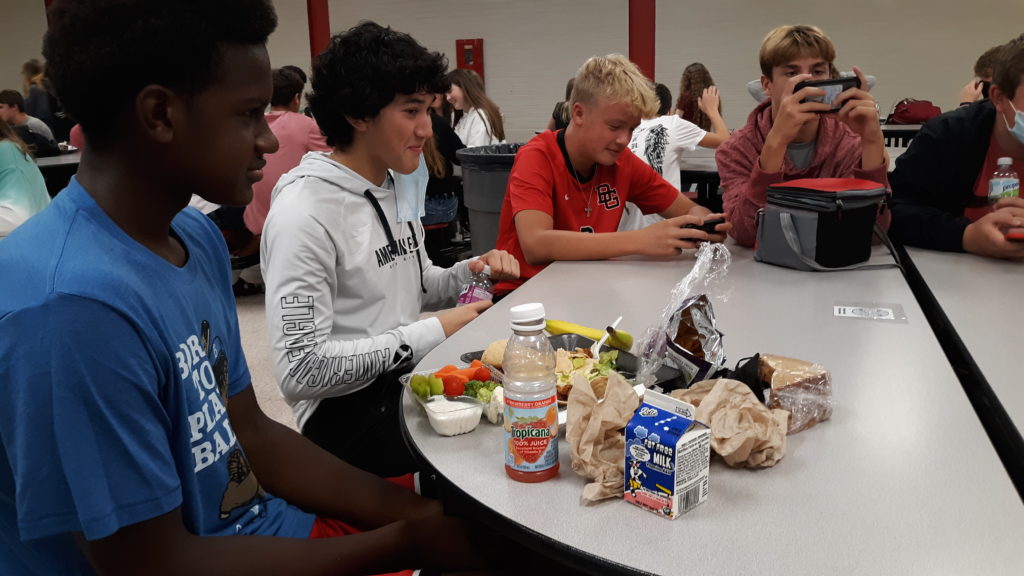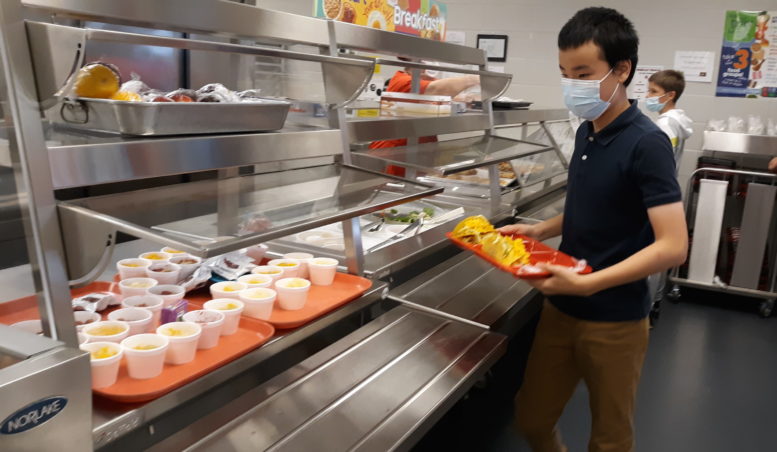By JAN LARSON McLAUGHLIN
BG Independent News
Supply chain and labor issues are eating into school cafeteria menus across the nation.
“It’s a different item every week that we can’t get – bread, chicken, sporks,” said Abby Forschner, food service director for Bowling Green City Schools.
“We’re having trouble getting turkey now because companies don’t have people to debone the turkey,” Forschner said. And since private businesses pay more for food supplies, schools are not a priority.
“We tend to be at the bottom of the ladder for food,” she said.
With the food shortages, Forschner does a lot of running between school buildings to fill in food where needed.
“There’s a lot of sharing going on,” she said.

And some new menu items are showing up on cafeteria trays.
“They do expect this won’t end until the end of the school year,” Forschner said. “We’re trying different ideas to get through it.”
Some student favorites have been tough to come by – such as the prized popcorn chicken with mashed potatoes and gravy – the most popular menu at Bowling Green’s elementaries and secondary schools.
“We’ve had a little issue getting the chicken – so it’s a little different,” Forschner said.
The same goes for the beloved Bosco sticks, another student favorite.
I’m able to get them, they are just a different kind,” with the new breadsticks having pepperoni inside, she said.
The kids notice – even if it’s a slight change, she said.
“A lot of students don’t like change,” Forschner said. “They can be very discerning.”

Tuesday was taco day at the high school and middle school. Sophomore Ahmir Ruffin loaded up his tray with two soft tacos with ground beef, veggies and dip, two peanut butter and jelly sandwiches, a banana and nacho chips.
“The tacos are good,” Ruffin said, though the rest of his table chimed in to say the customary “walking tacos” served are better.
Ruffin, who has the bottomless pit stomach of a teenager who runs cross country and plays basketball and baseball, said the pile of food in front of him wouldn’t go to waste. “I’ll probably eat all of it,” he said.
Some new items have passed the test for students – like Asian food day at the elementaries.
“We’re just trying to make the best of what we have. The kids loved it,” Forschner said.

But not every new item has passed the taste test for students – like the bean burritos.
“They are never shy to tell you how they feel,” she said. “That’s the one thing they just did not go for.”
Despite the shortages, Forschner assured that students are still getting ample food and the district is still meeting federal nutrition standards.
“This is where some parents get confused,” she said.
The schools must serve a protein, grain, fruit, vegetable and milk each day.
“But students are only required to take three,” she said. “Then they are still hungry.”

The high school students are allowed a higher calorie intake, and the middle school and high school have more options, like salad bars, that can help fill up students.
“Kids love them,” she said of the salad bars with fresh vegetables and fruit.
Forschner said the district works hard to give students nutritional food that they will eat.
“If that’s the only meal of the day for a student, I want it to be something they will eat,” she said.
Some food items require Forschner to jump through a lot of hoops. For example, since the USDA wants cafeterias to serve foods produced in America, Forschner has to fill out a waiver form to get bananas on the menu.

Last month, Bowling Green City Schools served approximately 26,000 lunches and 10,000 breakfasts.
“We’re seeing a big swing in lunches,” Forschner said.
Part of that uptick is likely due to the federal government’s decision during COVID that all public school lunches should be free for students. The free lunches will continue at least till the end of this school year, according to Forschner.
“The response has been so positive. I could see it continue,” she said.
Meanwhile the food prices have increased for the school district. Normally the district purchases government subsidized food. But with those supplies being short, the district has had to buy some food at retail prices, she said.
While the lunches are free, students who want a second cheeseburger or extra piece of pizza have to pay.

The high school also has a “snack bar” squeezed into a small area off of the cafeteria. There students can purchase healthier whole wheat or low sugar snacks approved by the USDA.
“Kids tell me, ‘We want Little Debbie’s and Hostess,’” Forschner said. “But I tell them I’ve got to follow the rules.”
Forschner said she has agonized over providing students adequate amounts of foods they will actually eat.
“I stress myself out. But the students complain less than their parents,” she said.
Last week, a member of the food service staff told Forschner about the cafeteria lunches taking a beating on social media. The short-staffed cafeteria workers were distressed about the criticism.
“I told the staff not to look at it. We’re having a hard enough time as it is,” Forschner said.

